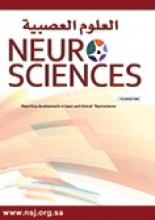Research ArticleOriginal Article
Open Access
Incidence of autism in high risk neonatal follow up
Hussein S. Mohammed, Saeed H. Wahass and Adel A. Mahmoud
Neurosciences Journal January 2016, 21 (1) 43-46; DOI: https://doi.org/10.17712/nsj.2016.1.20150471
Hussein S. Mohammed
From the National Neuroscience Institute (Mohammed), Mental Health Department and Pediatric Neurology Department (Mahmoud), King Fahad Medical City, Riyadh, the Department of Psychiatry (Wahass), College of Medicine, Dammam University, Dammam, Kingdom of Saudi Arabia
PhDSaeed H. Wahass
From the National Neuroscience Institute (Mohammed), Mental Health Department and Pediatric Neurology Department (Mahmoud), King Fahad Medical City, Riyadh, the Department of Psychiatry (Wahass), College of Medicine, Dammam University, Dammam, Kingdom of Saudi Arabia
PhD, AFBPsSAdel A. Mahmoud
From the National Neuroscience Institute (Mohammed), Mental Health Department and Pediatric Neurology Department (Mahmoud), King Fahad Medical City, Riyadh, the Department of Psychiatry (Wahass), College of Medicine, Dammam University, Dammam, Kingdom of Saudi Arabia
PNF Ca, MRCPCH
References
- ↵
- American Psychiatric Association
- ↵
- Raz R,
- Roberts AL,
- Lyall K,
- Hart JE,
- Just AC,
- Laden F,
- et al.
- ↵
- Dickerson AS,
- Rahbar MH,
- Han I,
- Bakian AV,
- Bilder DA,
- Harrington RA,
- et al.
- ↵
- Pagon RA,
- Bird TC,
- Dolan CR,
- Stephens K
- Miles JH,
- Mc Cathren RB,
- Stichter J,
- Shinawi M
- ↵
- Saugstad OD
- ↵
- Raina SK,
- Kashyap V,
- Bhardwaj AK,
- Kumar D,
- Chander V
- ↵
- Centers for Disease Control and Prevention
- ↵
- Al Zahrani AH
- ↵
- Al-Salehi SM,
- Al-Hifthy EH,
- Ghaziuddin M
- Raz R,
- Weisskopf MG,
- Davidovitch M,
- Pinto O,
- Levine H
- Lenoir P,
- Bodier C,
- Desombre H,
- Malvy J,
- Abert B,
- Ould Taleb M,
- et al.
- Lian WB,
- Ho SK
- ↵
- Aarnoudse-Moens CS,
- Weisglas-Kuperus N,
- van Goudoever JB,
- Oosterlaan J
- ↵
- Limperopoulos C,
- Bassan H,
- Sullivan NR,
- Soul JS,
- Robertson RL Jr.,
- Moore M,
- et al.
- ↵
- American Psychiatric Association
- ↵
- Lewis JR,
- Saur J
- ↵
- IBM SPSS Statistics For Windows. Version 22
- ↵
- Sigurdsson E,
- Van Os J,
- Fombonne E
- ↵
- Pine D,
- Shaffer D,
- Schonfeld IS
- ↵
- Buka SL,
- Fan AP
- ↵
- Wahlbeck K,
- Osmond C,
- Forsén T,
- Barker DJ,
- Eriksson JG
- ↵
- Jones PB,
- Rantakallio P,
- Hartikainen AL,
- Isohanni M,
- Sipila P
- ↵
- Abel KM,
- Dalman C,
- Svensson AC,
- Susser E,
- Dal H,
- Idring S,
- et al.
- ↵
- Kuehn BM
- ↵
- Pyhälä R,
- Hovi P,
- Lahti M,
- Sammallahti S,
- Lahti J,
- Heinonen K,
- et al.
- ↵
- Mahoney AD,
- Minter B,
- Burch K,
- Stapel-Wax J
- ↵
- Mamidala MP,
- Polinedi A,
- P T V PK,
- Rajesh N,
- Vallamkonda OR,
- Udani V,
- et al.
In this issue
Incidence of autism in high risk neonatal follow up
Hussein S. Mohammed, Saeed H. Wahass, Adel A. Mahmoud
Neurosciences Journal Jan 2016, 21 (1) 43-46; DOI: 10.17712/nsj.2016.1.20150471
Jump to section
Related Articles
- No related articles found.
Cited By...
- No citing articles found.





